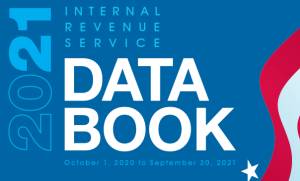
Along with frustrating backlogs, declining audit rates have been the topic of many accountant discussions regarding how IRS budget constraints have affected taxpayers. The latest IRS statistics confirm the declining audit numbers.
On May 26, 2022, the IRS released its Data Book, 2021 (Publication 55-B). The Data Book, published annually since 1863, contains statistical tables describing a full range of IRS activities, including returns, collections, refunds, enforcement, and the IRS workforce. The recent report covers the fiscal year ending Sept. 30, 2021. This is the first full tax year affected by COVID-19.
The first table, “The tax Year 2019 Audit Rates Over Time,” below, shows IRS audit rates for the tax year 2019 measured as of Sept. 30, 2021, and May 1, 2022. It includes the following types of audits:
- Office, field, large business, and international cases, including high-wealth individuals;
- Correspondence exams; and
- Underreporter inquiries (CP 2000).
Normally, a taxpayer who qualifies for the earned income tax credit (EITC) has income under $100,000. The relatively high audit rate for the EITC includes the IRS EITC anti-fraud initiatives.
To understand the significance of the 2019 audit rates, it is important to compare them with those of prior years. The table “Audit Rates Over Time,” below, compares audit rates for tax years 2017 and 2010. Here we can see a dramatic decline in the percentage of taxpayers audited over the eight-year period, with the largest decreases in the highest income categories.
The IRS claims to aggressively audit high-income taxpayers and businesses; yet these statistics show that even by 2017 the overall audit rates had declined precipitously, with high-income returns seeing the greatest decline in audits. For example:
- Audit rates for individual income tax returns with total income between $200,000 and $500,000 declined by 82.1%.
- Corporations with assets between $250 million and $500 million had audit rates reduced by 66%.
The Transactional Records Access Clearinghouse (TRAC) at Syracuse University noted that in 2021, “out of over 160 million individual income tax returns that were filed, the IRS audited 659,003 — or just 4 out of every 1,000 returns filed (0.4%)” (Syracuse University TRAC, “IRS Audits Poorest Families at Five Times the Rate for Everyone Else” (March 8, 2022)).
“All but 100,000 of the 659,000 audits were conducted [by correspondence]” (id.). TRAC also notes that “over half of these correspondence audits were targeted at [EITC recipients]” (id.).
In the fiscal year 2021, the number of those with over $1 million of positive income audited by the IRS did have a slight increase over the fiscal year 2020 — from 11,331 to 13,725. However, the 2021 number was still below that of 2019 (13,970) (id.).
“Despite this modest improvement [in 2021], [the] IRS was still only managing to conduct about a third of the millionaire audits it had completed during the fiscal year 2015” (id.).
Ashlea Ebeling, writing in Forbes this year, reached the conclusion that “[o]n average, individual tax returns were audited over three times more often for the tax year 2010 (0.9%) than for the tax year 2019 (0.25%)” (Ebeling, “IRS Tax Return Audit Rates Plummet,” Forbes Personal Finance (May 18, 2022)).
The decline in audit rates can partially be explained by the reduction in full-time-equivalent (FTE) IRS revenue agents and tax examiners, which in the fiscal year 2021 totaled 17,079 (IRS, Data Book, 2021, Table 32). For comparison, the number of FTE employees in these categories for the fiscal year 2011 was 38% higher at 23,556 (IRS, Data Book, 2012, Table 30).
Ebeling also attributes the reduction in audit rates to IRS staff shortages resulting from decreased funding, and elaborates: “Since the fiscal year 2011, the number of tax examiners who work basic audits, usually by mail, decreased by 18%, and the number of revenue agents who work on complex in-the-field audits decreased by more than 40%.”
In conclusion, the IRS, primarily due to funding cuts, employs significantly fewer revenue agents and tax examiners than a decade ago. This has led to an overall decline in audit rates for individuals and corporations. High-income taxpayers have received the greatest reductions proportionately in audit rates. Indications are that the significant attrition of revenue agents and tax examiners will continue. Even with increases in funding, it appears that the IRS is years away from having a robust core of tax examiners and from having audit numbers comparable to 10 years ago.


